Bulbs
Flower Basics
Flower Beds & Specialty Gardens
Flower Garden
Garden Furniture
Garden Gnomes
Garden Seeds
Garden Sheds
Garden Statues
Garden Tools & Supplies
Gardening Basics
Green & Organic
Groundcovers & Vines
Growing Annuals
Growing Basil
Growing Beans
Growing Berries
Growing Blueberries
Growing Cactus
Growing Corn
Growing Cotton
Growing Edibles
Growing Flowers
Growing Garlic
Growing Grapes
Growing Grass
Growing Herbs
Growing Jasmine
Growing Mint
Growing Mushrooms
Orchids
Growing Peanuts
Growing Perennials
Growing Plants
Growing Rosemary
Growing Roses
Growing Strawberries
Growing Sunflowers
Growing Thyme
Growing Tomatoes
Growing Tulips
Growing Vegetables
Herb Basics
Herb Garden
Indoor Growing
Landscaping Basics
Landscaping Patios
Landscaping Plants
Landscaping Shrubs
Landscaping Trees
Landscaping Walks & Pathways
Lawn Basics
Lawn Maintenance
Lawn Mowers
Lawn Ornaments
Lawn Planting
Lawn Tools
Outdoor Growing
Overall Landscape Planning
Pests, Weeds & Problems
Plant Basics
Rock Garden
Rose Garden
Shrubs
Soil
Specialty Gardens
Trees
Vegetable Garden
Yard Maintenance
How to Grow Hot Peppers Indoors
How to Grow Hot Peppers Indoors. Imagine offering your friends freshly picked hot peppers in the dead of winter. If you grow hot peppers indoors, you can pluck them off the plant to add this tasty delicacy to your fare. The great part of growing your own plants is that you select the varieties you want and don't depend on the local grocer to carry...

Imagine offering your friends freshly picked hot peppers in the dead of winter. If you grow hot peppers indoors, you can pluck them off the plant to add this tasty delicacy to your fare. The great part of growing your own plants is that you select the varieties you want and don't depend on the local grocer to carry them. Growing hot peppers indoors is not difficult, but if you want to grow peppers indoors and have them produce, that takes a little more effort and equipment.
Things You'll Need
Growing medium
Peat pots
Seeds
Propagation or heat mat
Water
HID light or other strong lighting
Larger pots
Spray bottle
Dish soap
Netting
Find the best species to grow inside the house. Some types of hot peppers love it indoors such as chiltepins, habaneros, piqu'ns and Thai peppers. These plants produce flowers and fruit for a longer time than other hot peppers. They're also small but mighty when it comes to flavor. If you're really ready for hot, plant a few Naga Jolokia pepper seeds. These are the hottest peppers available.
Mix your own potting soil or purchase some. Make sure yours is sterile if you make it yourself.
Fill a 3-inch peat pot about 3/4 inch from the top with moistened potting soil. Sew 2 to 3 pepper seeds per pot and cover with 1/4-inch of soil. Water the pot thoroughly and set it in a warm area. These plants like a temperature around 80 degrees to germinate, so you may need to add heat above and below the pots. Use a propagation mat to accomplish this.
Keep the soil moist but not wet. This leads to fungus growth and damping off of the seedlings. It takes between 2 to 5 weeks for the chili seed to germinate. Don't over water while germination takes place.
Check for the first plants to pop through the soil then make sure your seedlings get adequate light. They need at least 16 hours of light in order to grow their best. You can start the seedlings with fluorescent light but if you want them to grow indoors and produce, you need to use a stronger light like the HID grow light found in the resource area. These produce more lumens necessary for the plant to thrive. Peppers like water but don't like to get their feet wet. Don't allow the containers to sit in water. Pour off any excess.
Maintain the temperature of 75 to 80 degrees around the plants. Remember, their natural environment gets hot during the day, between 80 to 90 degrees on a regular basis during the day and around 70 degrees at night. Try to mimic these conditions. The HID lamp produces heat, so if you use one, this adds to the heat for the area. Heat shields for the plant also increase the area heat. If you use a fluorescent tube and place it 3 inches above the plant, you can raise the temperature as much as 10 degrees. A heat mat also gives more warmth.
Transfer the seedlings to larger pots or thin out when the plant gets its first set of true leaves. Continue to increase the size of the pot when you feel that the plant starts to outgrow it.
Look out for some pests. Even though the plants are indoors, it doesn't stop some pests. Spider mites and sometimes aphids attack indoor plants. If you find a problem, a spray bottle of water with a few drops of dishwashing liquid can provide a solution. Just mix 24 ounces of water to 4 drops of dish soap and spray.
Cover some of your plants during flowering time, if you have a mixture of various types together. Even though hot peppers are self pollinators, you should either keep different varieties away from each other or cover the plants with a thin mesh cloth. This guarantees that no cross breeding takes place.